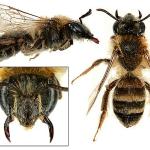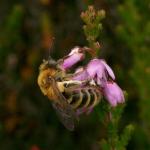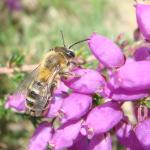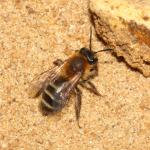Andrena fuscipes is a medium-sized Andrena, one of a group of five species (A. denticulata, A. fuscipes, A. nigriceps, A. simillima, A. tridentata) where the females have distinctive, triangular hind tibiae which do not incurve distally and with a strongly banded appearance to the copiously-haired abdomen. Within the group the species are all rather similar, especially the males. The silver-grey males may be found in numbers dashing over the tops of flowering heather plants.
This species is locally common on heather-dominated heathlands, being found throughout Great Britain, although more localised than its heather pollen-source in the north of Scotland. It is probable that our populations are a significant proportion of the overall European population; especially in view of the very large proportion of remaining heathland and moorland in these islands. It is widespread, but rarely common, in Europe. It has been categorised as Red List 2, Severely Endangered, in Germany.
This species is not regarded as being scarce or threatened.
Very strongly linked to substantial areas of flowering heather.
Univoltine: July to September.
Nests singly in areas of bare ground amongst heathers.
Males and females are rarely seen at anything other than heather.
The cuckoo-bee Nomada rufipes Fabricius parasitises this species.
2006





